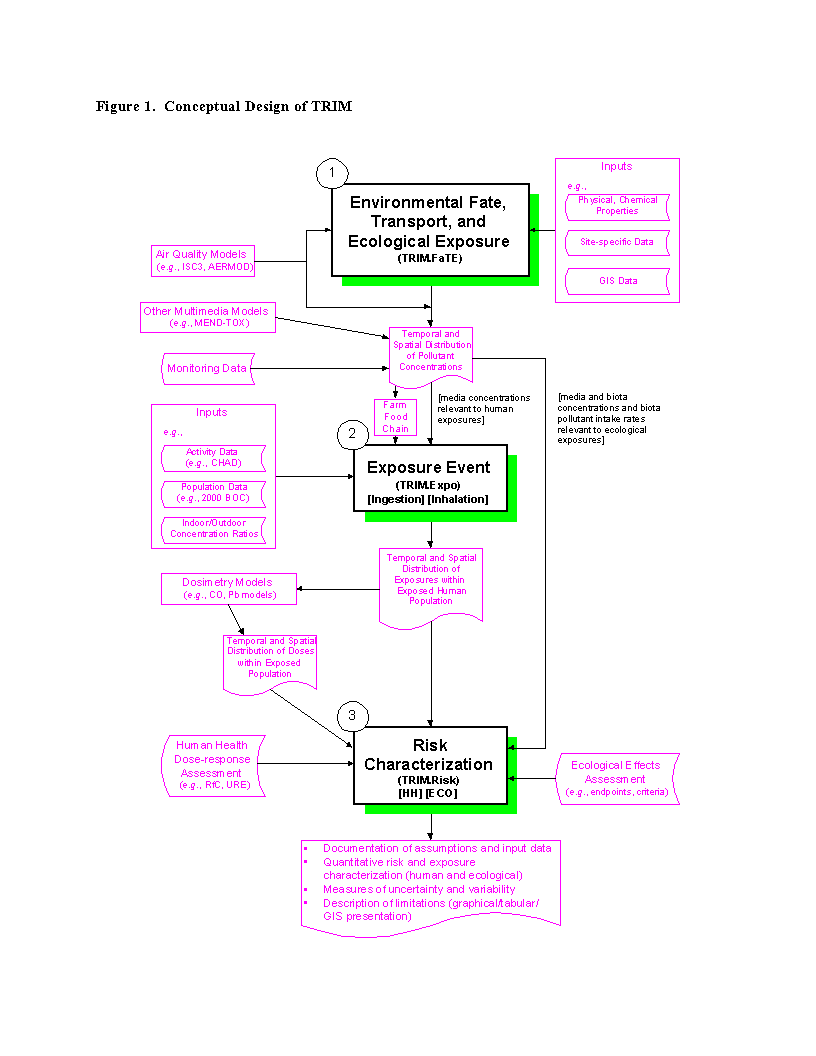Total Risk Integrated Methodology (TRIM) - Overview
The TRIM design includes three individual modules which have been the subject of peer review and publication:
- The Environmental Fate, Transport, and Ecological Exposure module, TRIM.FaTE, accounts for movement of a chemical through a comprehensive system of discrete compartments (e.g., media and biota) that represent possible locations of the chemical in the physical and biological environments of the modeled ecosystem and provides an inventory, over time, of a chemical throughout the entire system. In addition to providing exposure estimates relevant to ecological risk assessment, TRIM.FaTE generates media concentrations relevant to human ingestion exposures that can be used as input to the ingestion component of the Exposure-Event module, TRIM.Expo.
- In TRIM.Expo, human exposures are evaluated by tracking either randomly selected individuals that represent an area's population or population groups referred to as "cohorts" and their inhalation and ingestion through time and space. The inhalation component is currently available.
- In the Risk Characterization module, TRIM.Risk, estimates of human exposures or doses are characterized with regard to potential risk using the corresponding exposure- or dose-response relationships. The TRIM.Risk module is also designed to characterize ecological risks from multimedia exposures. The output from TRIM.Risk is intended to include documentation of the input data, assumptions in the analysis, and measures of uncertainty, as well as the results of risk calculations and exposure analysis.
The uncertainty and variability features (e.g., sensitivity and Monte Carlo analysis) augment TRIM's capability for performing iterative analyses. For example, the user may perform assessments varying from simple deterministic screening analyses using conservative default parameters to refined and complex risk assessments where the impacts of parameter uncertainty and variability are assessed for critical parameters.
Given the modular design of TRIM, the user selects any one or more of the modules for an assessment depending on their needs.
- For example, when performing a human health risk assessment for an air pollutant for which multimedia distribution is not significant, it is recommended that TRIM.Expo-inhalation be applied to ambient concentration data or the output from an air quality model external to TRIM (i.e., not TRIM.FaTE). The output from TRIM.Expo may then be input to TRIM.Risk to perform the desired risk analyses.
- In the case of a multimedia air pollutant, such as mercury, the user may choose to run all three TRIM modules (when available) to assess ecological risks posed by multi-pathway exposures from multiple media, as well as human ingestion risks posed by exposure from multiple pathways.
In the development of TRIM, existing models and tools are being relied upon where possible. For example, EPA has incorporated TRIM into EPA's MIMS, a modeling framework that accommodates linkages among multiple models and the sharing of common tools and data.

